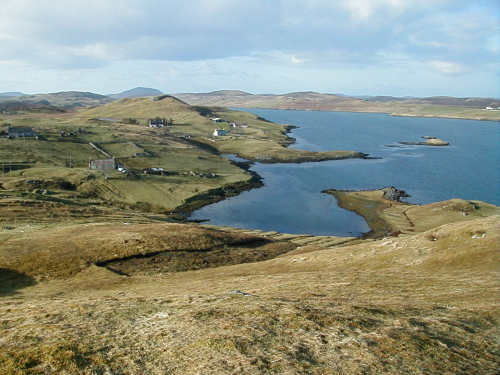From Patagonia to Crobeg
WHEN Charles Menendez MacLeod (Charlie Barley) bought the Crobeag Farm, including Eilean Chaluim Cille, in 1957, he was in essence returning to the land of his forefathers. It was in Garyvard, a short distance across Loch Erisort from St. Colms’ Isle that his great, great, great-grandfather, Torquil MacLeod, and his wife, Ann Matheson, lived in the late 17th and early 18th Century. Their son, Donald, moved over the Loch to Keose on his marriage to Ann MacDonald thereby establishing the family’s association with the croft at 5 Keose that was to remain their home until Charles’ father, Murdo, moved to Ropework Cottage, Stornoway, after his marriage to Chrissie MacKenzie. Chrissie was a descendant of Charles MacKenzie (1776-1845), of Leurbost, who had moved to 7 Keose around 1819. On the paternal side, his family had links to the Martins of Ensay, Harris, and the MacDonalds of Ranish.
Charlie’s father had left Keose to go and work on the sheep farming stations of Patagonia in South America. Bruce Chatwin’s book, In Patagonia, describes the setting up of the sheep farms in 1877 when Henry Reynard, an English trader in Punta Arenas, ferried a flock from the Falkland Islands and set it to graze on Elizabeth Island in the Straits of Magellan. It multiplied prodigiously and other merchants took the hint. The leading entrepreneurs were a ruthless Asturian, Jose Menendez, and his amiable Jewish son-in-law, Moritz Braun. The two were rivals at first, but later combined to assemble an empire of estancias, coal mines, freezers, department stores, merchant ships and a salvage department that was reputedly closer to piracy than salvage. Menendez died in 1918, leaving a proportion of his millions to King Alphonso XIII of Spain and was buried at Punta Arenas. The Braun and Menendez families continued to dominate the territory through their Company, La Anonima. They imported stud flocks from New Zealand, shepherds and their dogs from the Western Isles and farm managers from the British Army who stamped the smartness of the parade ground over the entire operation and turned the Province of Santa Cruz into a Spanish speaking outpost of the British Empire.
Murdo MacLeod spent several years in Patagonia in the employment of a family named Menendez. They were kindly and generous sheep farmers and Murdo enjoyed his time working with them so much so that when his son, Charles, was born in 1915, he was given the second name Menendez in tribute to Murdo’s affection for the family.
Charlie’s mother, Chrissie MacKenzie, was the daughter of Charles MacKenzie (born1853) and Kirsty MacKay whose forebears lived at 4 Achmore. On the maternal side, she was related to the MacAulays of Uig.
